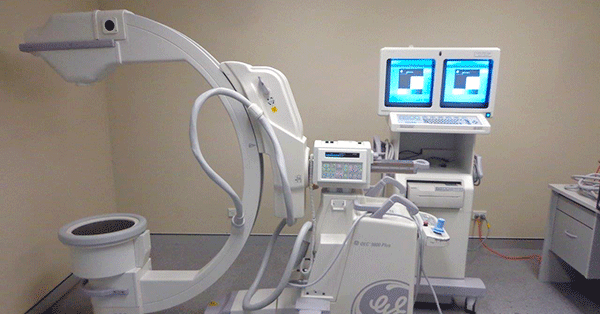
If you were to line an OEC Flexview 8800 C-arm up alongside an OEC 9800, you would probably get the impression that the 8800 was the 9800's "little brother".
In some ways, you would be correct. The 8800 is not quite the multi-specialty, workhorse system the 9800 is known for being, but there are plenty of scenarios where it will get the job done, or even be a better fit altogether.
Below we'll cover further details on the technical similarities and differences between the OEC 9800 and OEC 8800, cost difference, and which one may work for your facility.
OEC 9800 and OEC 8800 Similarities
From a mechanical and electrical standpoint these two C-Arms are very similar. They share the same boards, interface, keyboards, and 1K x 1K x 16 imaging chain.
The OEC 8800 has lots of parts crossover with the OEC 9800. With some exceptions, anyone needing replacement parts for an OEC 8800 will be able to benefit from the wide availability of parts for the OEC 9800.
If you or your imaging tech are familiar with the 9800, you'll feel comfortable operating the 8800 based on what we've listed above.
OEC 9800 and OEC 8800 Differences
The main difference between these two systems is their x-ray tube and how much power the tubes put out. The tube on the 9800 is a rotating anode, and the tube on the 8800 is a stationary anode.
You may be wondering, well what's the difference? As mentioned in our blog: STATIONARY ANODE VS. ROTATING ANODE: TWO C-ARM TUBE TYPES COMPARED, the main difference here is that one anode stays still (stationary) while the other spins around a fixed point (rotating).
The reason behind the introduction of rotating anodes is related to the dispersal of heat. Due to the large amount of heat produced AND that heat hitting the same spot over and over again, a stationary anode surface will eventually become deformed and the angle of the x-ray beam will shift. This causes reduced dose efficiency and image quality.
In the case of a rotating anode in the 9800, the system will shoot at a higher KV & MA for a longer period of time, allowing longer scans a higher doses.
Which C-Arm should I use in my facility?
Now that you know the similarities and differences between the 9800 and 8800, how do you choose which C-Arm is right for your facility? Consider these questions to help make a decision:
- What do you plan to use your c-arm for?
- How much is your budget?
The OEC 8800 is a great choice for pain management and short bursts of fluoro.
If you are planning to use your C-Arm for multiple studies and procedures, the OEC 9800 may be a better fit.
What is the Cost Difference?
The OEC 8800 on the secondary market average $31,000-$34,000*.
Pricing will depend on the hardware/software combination and the age of the particular system you're looking at.
OEC 9800 C-arms on the secondary market average between $48,000 - $54,000*.
Same as the 8800, pricing will depend on the hardware/software combination and age of the system.
The Takeaway
While the OEC 9900 is known for it's workhorse capabilities, the 8800 could more than meet your facilities needs depending on the studies you plan to perform and budget.
If you're ready to learn more about the OEC 9800, OEC 8800, or any other C-arm model, our team is ready to help.

Chris Sharrock
Chris Sharrock is the Vice President of Healthcare Solutions at Block Imaging. Each day Chris sets out to provide the best equipment, parts, and service solutions for healthcare facilities across the world. Outside of work Chris enjoys playing in a band, and spending time at the lake with his family.





